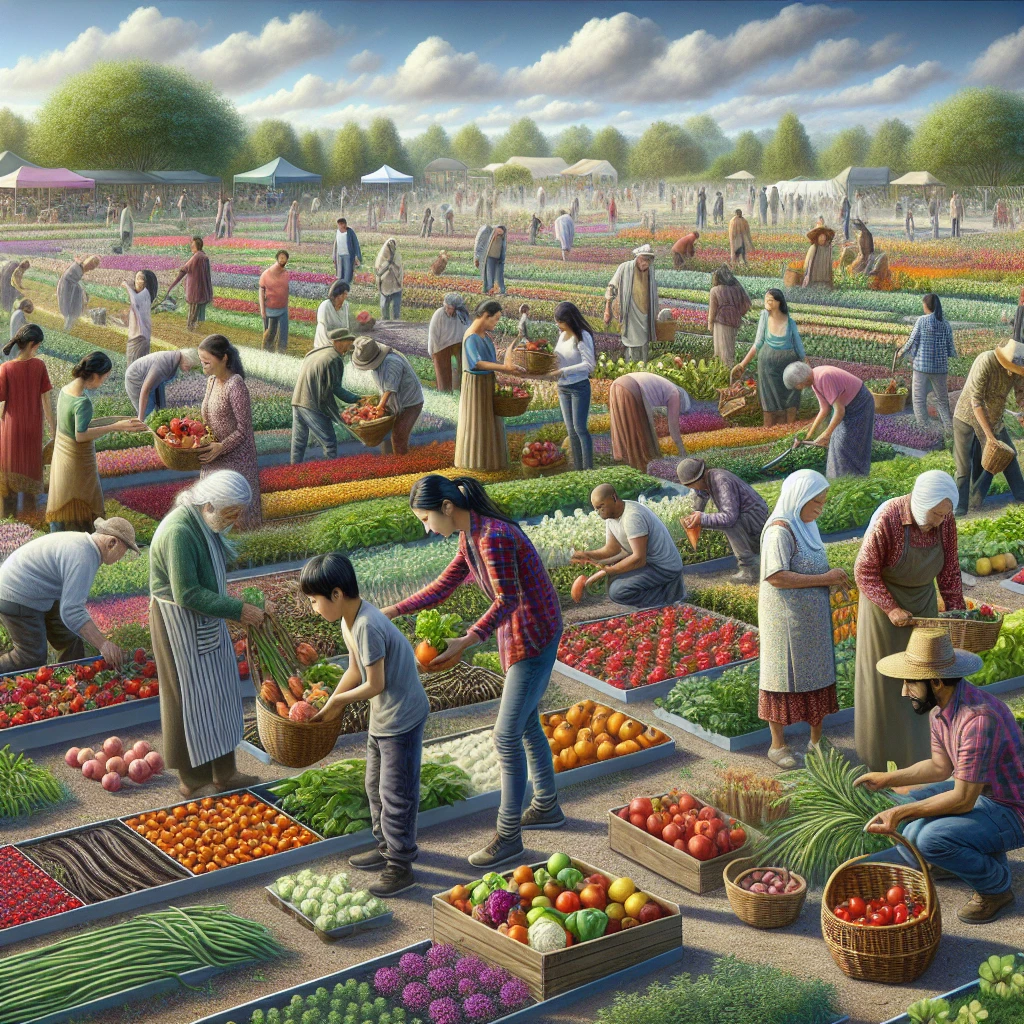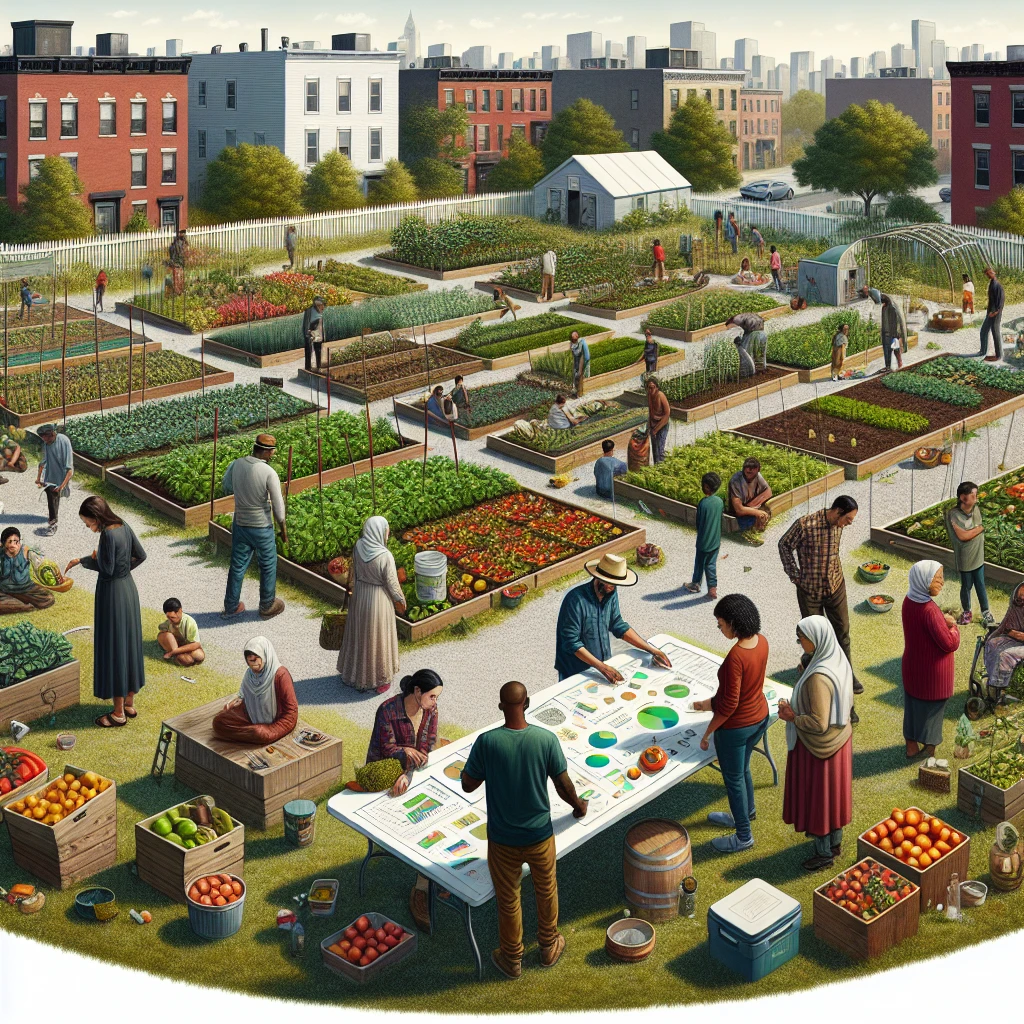

Food insecurity issues refer to the limited or uncertain access to adequate and nutritious food for individuals and communities. It may be influenced by factors such as income, employment, race/ethnicity, and disability, leading to a lack of consistent access to enough food for an active, healthy life.
The impact of food insecurity on individuals and communities includes physical health implications like obesity, diabetes, and asthma, as well as mental health implications such as anxiety, depression, and lower cognitive function. Furthermore, food insecurity has economic root causes and can lead to poor educational outcomes and lower lifetime earnings.
Check out this Youtube video: This video explores the critical issue of food insecurity and its impact on communities, shedding light on the urgent need for action.
Understanding Food Insecurity
Definition of food insecurity
- Food insecurity refers to the lack of consistent access to enough food for an active, healthy life. It is a household-level economic and social condition that leads to limited or uncertain access to adequate food. This condition can be temporary or prolonged, affecting individuals and families across different demographics and regions.
Causes and contributing factors of food insecurity
- The leading causes of food insecurity include inadequate income, lack of access to farming lands, and limited job opportunities. These factors contribute to the inability to afford quality food, leading to food insecurity. Additionally, societal issues such as racial disparities and disabilities can further exacerbate the problem.
Different levels of food insecurity (low, moderate, severe)
- Food insecurity is categorized into various levels based on severity. These levels include high food security, marginal food security, low food security, and very low food security. Each level represents different degrees of concern, ranging from worries about food running out to significant disruptions in eating patterns and reduced food intake.
| Food Insecurity Level | Description |
|---|---|
| High Food Security | Minimal to no concerns about food access or quality. |
| Marginal Food Security | Concerns that food may run out before being able to afford more. |
| Low Food Security | Reduced quality, variety, or desirability of food intake. |
| Very Low Food Security | Reports of disrupted eating patterns and significantly reduced food intake. |
Always remember, food insecurity is a pressing issue that requires collective efforts to address and eradicate it from our communities.
Impact of Food Insecurity on Health
Relationship between food insecurity and malnutrition
Food insecurity directly contributes to malnutrition, with studies showing a clear link between the two. In food-insecure households, the prevalence of underweight, wasting, and stunting in children is significantly higher compared to food-secure households.
This underlines the serious impact of food insecurity on malnutrition.
Effects of food insecurity on physical and mental health
The effects of food insecurity reach beyond physical health, impacting mental well-being as well. Adults facing food insecurity are more likely to experience anxiety, depression, and other mental health issues.
Moreover, food insecurity also leads to micronutrient deficiencies and lower diet quality, affecting overall health and sleep outcomes.
The link between food insecurity and chronic diseases
A noteworthy correlation exists between food insecurity and chronic diseases. Adults living in food-insecure households are at a significantly higher risk of being diagnosed with chronic conditions such as hypertension, coronary heart disease, and diabetes.
This emphasizes the detrimental impact of food insecurity on long-term health outcomes.
| Indicator | Food-Insecure Households | Food-Secure Households |
|---|---|---|
| Prevalence of underweight children (%) | 29.9 | 12.5 |
| Prevalence of wasting in children (%) | 17.8 | 6.2 |
| Prevalence of stunting in children (%) | 27.2 | 11.7 |
These comparisons underscore the stark differences in health outcomes associated with food insecurity, highlighting the urgent need for comprehensive interventions to address this pressing issue.
Addressing Food Insecurity in Vulnerable Populations
Food insecurity among low-income families
Food insecurity among low-income families is a pressing concern, with poverty being a significant contributing factor. The lack of affordable housing and chronic health conditions further exacerbates the issue.
While initiatives like community food banks and government assistance programs provide some relief, the root causes of low income and inadequate access to healthcare must be addressed to combat this widespread problem effectively.
Food insecurity in children and its long-term effects
Food insecurity in children has profound long-term effects, leading to delayed development, chronic illnesses like asthma and anemia, and behavioral problems such as hyperactivity and anxiety. Studies have consistently highlighted the detrimental impact of food insecurity on children’s overall well-being and their ability to thrive academically and socially.
Seniors and food insecurity issues
Seniors facing food insecurity consume fewer calories and nutrients, putting them at a higher risk of nutritional deficiencies. Poverty and limited access to resources further compound the challenges faced by older adults in accessing sufficient and healthy food.
The increase in food insecurity among seniors demands targeted interventions and support systems to ensure their nutritional needs are met effectively.
| Food Insecurity Issues | Solutions |
|---|---|
| Poverty | Economic empowerment and employment opportunities |
| Unemployment | Skill development programs and job placement initiatives |
| Lack of affordable housing | Affordable housing projects and community development programs |
| Chronic health conditions or lack of access to healthcare | Healthcare accessibility and affordable medical assistance programs |
In addressing food insecurity among vulnerable populations, it is imperative to recognize the intersecting factors and implement comprehensive solutions to provide sustainable support and alleviate the challenges faced by low-income families, children, and seniors.
The Role of Government and Policies
Since the welfare of its citizens is a top priority, the government has implemented several programs to address food insecurity. The USDA’s Food and Nutrition Service (FNS) administers 15 federal nutrition assistance programs, including the Supplemental Nutrition Assistance Program (SNAP) and school meals, which play a crucial role in addressing hunger and obesity in the United States.
Government programs addressing food insecurity
The FNS works tirelessly to combat food insecurity by providing access to healthy groceries through programs like SNAP, which supports approximately 43 million Americans in feeding themselves and their families. Moreover, the government also aids families facing food insecurity through various nutrition programs for women, children, and infants.
Effectiveness of food assistance programs
Studies have shown that SNAP participation reduces food insecurity by up to 30%, making it particularly effective for vulnerable populations, including children and those with very low food security. In fact, about 55% of food-insecure households were part of federal nutrition assistance programs such as SNAP, WIC, and the National School Lunch Program in 2020.
Advocacy for policy changes to combat food insecurity
In response to the ethical imperative of reducing food insecurity, the government is taking steps to strengthen nutrition assistance programs, emphasizing the need for just food policies that embrace compassion, create opportunity, consider essential needs, and promote knowledge and empathy. Moreover, there are ongoing efforts to provide additional funding to address increasing needs for nutrition assistance in certain U. S. territories.
| Program | Impact |
|---|---|
| SNAP | Reduces food insecurity by up to 30% |
| WIC | Supports food-insecure households |
| National School Lunch Program | Addresses hunger among schoolchildren |
The government’s commitment to battling food insecurity through these vital programs showcases its dedication to ensuring the well-being of its citizens.
Food Insecurity and the Environment
Connection between food insecurity and food production
The connection between food insecurity and food production is undeniable. Insufficient agricultural productivity, due to factors such as climate change, limited access to resources, and poor infrastructure, contributes to food scarcity.
This scarcity, in turn, leads to higher prices, making nutritious food unaffordable for many. Additionally, food insecurity can result from inadequate production in regions heavily reliant on agriculture, further highlighting the intricate link between food production and food security.
Climate change and its impact on food insecurity
Climate change poses a significant threat to food security by altering growing conditions, reducing crop yields, and increasing the frequency of extreme weather events. For example, excessive heat, droughts, and floods can devastate crops, disrupting food supplies and leading to shortages.
Additionally, changing weather patterns can affect the distribution and availability of arable land, exacerbating food insecurity in vulnerable regions.
Sustainable solutions to food insecurity
Sustainable solutions to food insecurity encompass various strategies, including enhancing agricultural practices, reducing food waste, and promoting local food production. By implementing regenerative farming methods and investing in resilient crop varieties, communities can adapt to the impacts of climate change and improve food security.
Furthermore, fostering equitable access to nutritious food through initiatives like community gardens and urban farming contributes to long-term sustainability.
| Sustainable Solutions | Description |
|---|---|
| Regenerative Farming Methods | Implementation of practices that restore soil health, enhance biodiversity, and mitigate climate impact |
| Community Gardens | Initiatives promoting local food production and increasing access to fresh, healthy foods |
| Equitable Food Distribution | Measures to ensure fair and equal access to nutritious food for all communities |
The intricate interplay between food production, climate change, and sustainable solutions significantly impacts food insecurity. By addressing these connections and adopting sustainable practices, we can work towards a more food-secure and environmentally resilient future.
Community Initiatives to Address Food Insecurity
Role of community food banks and food pantries
Community food banks and pantries play a pivotal role in addressing food insecurity by providing a lifeline to individuals and families in need. These organizations actively collect and distribute surplus, donated, or purchased food to those facing hunger.
Through extensive partnerships with local businesses, food banks ensure that no edible food goes to waste and is instead channeled to those experiencing food insecurity. By working with community-based organizations, these food banks directly impact the lives of individuals struggling to access nutritious meals.
Innovative programs to fight food insecurity at the local level
Innovative programs at the local level are emerging as effective tools against food insecurity. From urban gardening initiatives that empower communities to grow their own produce to meal preparation workshops that teach individuals how to make the most of limited resources, these programs are making a real difference.
Additionally, organizations are leveraging technology to facilitate access to food, with apps and online platforms connecting surplus food with those in need, contributing to an increase in overall food security within the local community.
Collaborations and partnerships in tackling food insecurity issues
Collaborations and partnerships are proving to be game-changers in the fight against food insecurity. By forming alliances with local businesses, non-profits, and government agencies, communities are able to create a robust network of support and resources.
These partnerships not only aid in the procurement and distribution of food but also facilitate the implementation of long-term solutions. Moreover, collaborations foster knowledge exchange and the sharing of best practices, driving innovation and sustainability in addressing food insecurity at the grassroots level.
| Organization | Role in Fighting Food Insecurity |
|---|---|
| Local Businesses | Providing surplus food and financial support for food programs |
| Non-profit Organizations | Facilitating community engagement and resource mobilization |
| Government Agencies | Implementing policies and programs to support food security |
By focusing on these three key areas, communities are taking significant strides in combating food insecurity through the implementation of targeted and sustainable initiatives.
Food Deserts and Access to Nutritious Food
Definition and characteristics of food deserts
Food deserts are areas where residents have limited access to affordable and nutritious food, typically due to the absence of grocery stores, supermarkets, and farmers’ markets within convenient reach. These areas are often characterized by smaller populations, higher rates of abandoned or vacant homes, and residents with lower levels of education, lower incomes, and higher unemployment.
Impact of food deserts on food insecurity
Living in a food desert significantly exacerbates food insecurity, leading to a higher risk of developing diet-related chronic diseases such as obesity. The absence of access to fresh fruits and vegetables and the overabundance of less healthful food options in the form of food swamps contribute to the profound food insecurity within these communities.
Strategies to increase access to nutritious food in food deserts
Communities can implement various interventions to make fresh, nutritious food more accessible, such as providing incentives for grocery stores and supermarkets to locate in underserved areas, improving public transportation to enhance access to markets, and implementing programs to grow fresh food closer to consumers. These strategies require a collaborative effort involving governmental, private, and grassroots support to address the complex issue of food deserts and improve access to nutritious food for all.
| Interventions | Description |
|---|---|
| Incentives for grocery stores and supermarkets | Encouraging their placement in underserved areas. |
| Public transportation improvements | Enhancing access to markets. |
Let’s tackle the issue of food deserts head-on and ensure that every community has access to nutritious and affordable food!
Education and Awareness on Food Insecurity
Importance of raising awareness about food insecurity issues
Food insecurity remains a critical concern affecting millions worldwide, demanding heightened awareness. By acknowledging the severity of this issue, we can drive actionable change and support individuals in accessing essential nutrition.
Raising awareness fosters empathy and encourages collaborative efforts to combat the alarming prevalence of food insecurity globally.
Addressing stigma and misconceptions surrounding food insecurity
Confronting the stigmas associated with food insecurity is crucial in fostering a supportive environment for affected individuals. Dispelling misconceptions and unwarranted judgments is imperative for building inclusive communities that offer assistance without prejudice.
Addressing the stigma can help create a safe space for individuals to seek aid and support without fear of discrimination.
Educational programs to empower individuals and communities
Implementing educational initiatives is pivotal in empowering individuals and communities to effectively combat food insecurity. By providing access to resources, nutritional guidance, and practical skills, these programs equip people to make informed choices and access essential support.
Empowering communities through education can catalyze sustainable solutions and create a more resilient, food-secure future.
| Pros of Educational Programs | Cons of Educational Programs |
|---|---|
| 1. Empowers individuals to make informed dietary choices | 1. Limited reach to remote or underserved areas |
| 2. Equips communities with practical skills for sustainable food access | 2. Resource-intensive to maintain comprehensive programs |
| 3. Fosters collaboration and community engagement | 3. Need for continuous adaptation to evolving nutritional needs |
Economic Factors and Food Insecurity
Poverty and its correlation to food insecurity
Poverty and food insecurity are closely linked, as limited financial resources often lead to inadequate access to nutritious meals. For example, in low-income communities, families may struggle to afford fresh produce and lean proteins, resulting in a higher prevalence of food insecurity.
This correlation underscores the need for targeted interventions to address economic disparities and enhance food accessibility.
Food insecurity and its impact on economic productivity
Food insecurity directly impacts economic productivity by contributing to health complications and reduced workforce efficiency. For instance, individuals experiencing food insecurity are more susceptible to chronic illnesses, leading to increased healthcare costs and absenteeism.
Moreover, malnutrition can impair cognitive function, hindering educational and professional advancement. Addressing food insecurity is vital for fostering a robust economy and nurturing a thriving workforce.
Breaking the cycle of poverty and food insecurity
Breaking the cycle of poverty and food insecurity requires multifaceted strategies, such as implementing sustainable employment opportunities, enhancing educational resources, and ensuring equitable access to nutritious food. For example, empowering underserved communities through skill-building programs and fostering entrepreneurship can promote economic independence and reduce the risk of food insecurity.
Additionally, advocating for inclusive policies and social safety nets can create a lasting impact on poverty alleviation and food security.
Food Waste and Food Insecurity
Link between food waste and food insecurity
The link between food waste and food insecurity is undeniable. When perfectly good food is discarded, it not only represents a loss for the individual who could have consumed it but also contributes to the scarcity of food resources for those in need.
In essence, the wastage of food directly exacerbates the problem of food insecurity, creating a vicious cycle that impacts communities on a large scale.
Innovative solutions to reduce food waste and alleviate food insecurity
Innovative solutions to combat food waste and alleviate food insecurity have emerged, offering rays of hope amidst these challenges. Technologies like Apeel, Full Harvest, and Hazel Technologies have revolutionized the preservation and distribution of food, significantly reducing waste.
Moreover, on-farm storage and the collaboration between food recovery organizations and food assistance programs have played a pivotal role in ensuring that surplus food reaches those experiencing food insecurity.
Collaborations between food rescue organizations and food assistance programs
The collaborations between food rescue organizations and food assistance programs are essential in addressing food insecurity. These partnerships enable the efficient channeling of excess food from suppliers and retailers to organizations that distribute it to individuals and families in need.
By rescuing and redistributing food that would otherwise go to waste, these initiatives play a crucial role in tackling food insecurity while promoting sustainability and resource optimization.
| Innovative Solutions | Description |
|---|---|
| Apeel | Technology designed to extend the shelf life of produce, reducing the likelihood of it being wasted. |
| Full Harvest | Platform connecting farms with food businesses to repurpose surplus and imperfect produce, preventing waste. |
| Hazel Technologies | Develops packaging solutions that maintain the freshness and quality of food, enhancing its shelf life and minimizing waste. |
Provided the current disposition towards environmental conservation, these innovative techniques can effectively reduce food waste and provide additional resources to those grappling with food insecurity. By promoting and sustaining partnerships between food rescue organizations and food assistance programs, society can address these critical issues while fostering a more sustainable and equitable future for all.
International Perspectives on Food Insecurity
Global impact of food insecurity
The global impact of food insecurity is staggering, with approximately 2.37 billion people facing inadequate access to food in 2020, representing an increase of almost 320 million individuals from the previous year. Shockingly, around 660 million people may still face hunger in 2030, a result of the lingering effects of the COVID-19 pandemic on global food security. Additionally, a striking 29.6% of the global population experienced food insecurity in 2022, marking a significant rise from the 25.3% reported in 2019. This dire situation calls for immediate and comprehensive action to tackle the underlying issues and provide relief to those in need.
Initiatives and programs addressing food insecurity worldwide
Across the globe, various organizations and initiatives have been tirelessly working to combat food insecurity. The World Food Programme (WFP) stands at the forefront, aiming to provide food assistance to over 80 million people in 80 countries while continuing to respond to emergencies.
Additionally, the Food and Agriculture Organization (FAO) and the World Bank have been proactively addressing the escalating crisis through strategic actions such as supporting production and producers, facilitating enhanced trade in food and production inputs, and investing in sustainable food security. These concerted efforts are crucial in alleviating the pressing challenges posed by food insecurity.
Challenges and opportunities in combating food insecurity on a global scale
While significant progress has been made in addressing food insecurity, numerous challenges persist on both the production and consumption fronts. Factors such as inflation rates exceeding 5% in low-income countries, double-digit inflation in many nations, and notable increases in food prices underscore the complexity of the issue.
To effectively combat these challenges, it is imperative to accelerate progress and address the major drivers of food insecurity and malnutrition. Furthermore, the inequalities affecting millions’ access to food must be tackled to eradicate hunger by 2030 as envisioned.
Despite these challenges, the initiatives and programs in place present valuable opportunities to make a profound difference in the global fight against food insecurity.
Comparison of Initiatives and Institutions Addressing Food Insecurity
| Initiatives/Programs | Focus | Action |
|---|---|---|
| World Food Programme (WFP) | Providing food assistance to over 80 million people in 80 countries and responding to emergencies | Offering crucial support to those vulnerable to hunger |
| Food and Agriculture Organization (FAO) | Proactively addressing the crisis through strategic actions, such as supporting production and facilitating increased trade in food | Responding to the rising food insecurity through sustainable measures |
The complex global impact of food insecurity necessitates a concerted effort to address the challenges through comprehensive initiatives and programs. As the world continues to grapple with this critical issue, the combined actions of organizations such as the WFP, FAO, and the World Bank offer hope for a future where food insecurity is eradicated.
Now, this is how we’re going to make food security great again!
Addressing Food Insecurity Through Technology
Utilizing technology to improve food distribution and access
To combat food insecurity, technological advancements have revolutionized food distribution and access. Companies like Softrobotics, SynTouch, and IBM Research have integrated innovative technologies such as robots, temperature and moisture sensors, aerial images, and GPS technology to streamline food transportation and logistics.
These advancements have made the distribution process more efficient, ensuring that food reaches those in need in a timely manner.
Innovative apps and platforms addressing food insecurity
Innovative apps such as OpenMeal and HelpKitchen from Twilio have emerged as powerful tools in addressing food insecurity. OpenMeal, for example, functions as an online platform that collects donations to support businesses and individuals struggling with food insecurity.
Such apps have effectively mobilized resources and facilitated the efficient distribution of food aid to those in need.
The role of social media in raising awareness about food insecurity
Social media has played a crucial role in raising awareness about food insecurity. Platforms like Twitter and Instagram have enabled the creation of virtual communities focused on combating food insecurity, using relevant hashtags to bring attention to the issue.
Social media has facilitated strategic collaboration and partnerships at both the local and global levels, amplifying the dialogue around food security and driving meaningful change.
| App/Platform | Functionality |
|---|---|
| OpenMeal | Collects donations to support those in need |
| HelpKitchen from Twilio | Offers aid to individuals and businesses |
Unlocking the potential of technology and leveraging the reach of social media has become instrumental in the battle against food insecurity, paving the way for a brighter, more food-secure future.
Mental Health and Food Insecurity
Psychological impact of food insecurity
Food insecurity has a significant psychological impact, leading to increased risks of anxiety and depression. Research from the CDC shows a 257% higher risk of anxiety and a 253% higher risk of depression associated with food insecurity.
Addressing mental health issues related to food insecurity
Addressing mental health issues related to food insecurity is crucial. Providing access to mental health resources such as counseling and support groups can help individuals cope with the psychological effects of food insecurity.
It’s essential to create a supportive environment that promotes mental well-being.
Support systems and resources for individuals experiencing food insecurity
Connecting individuals experiencing food insecurity to resources such as food assistance programs like WIC and SNAP can provide crucial support. Conducting food insecurity screenings, developing accessible databases of social resources, and implementing active outreach efforts can help ensure that individuals have access to the essential support they need.
Food Insecurity and Racial Disparities
Disproportionate impact of food insecurity on minority communities
- The disproportionate impact of food insecurity on minority communities is a grave concern. For instance, in 2022, nearly 23% of Black individuals experienced food insecurity, nearly three times the rate of white households. This stark contrast sheds light on the severe challenges faced by minority communities in accessing adequate nutrition.
Institutional barriers contributing to racial disparities in food insecurity
- Institutional barriers have played a significant role in contributing to racial disparities in food insecurity. For instance, the systemic issues such as poverty, unemployment, and incarceration, deeply intertwined with race and ethnicity, have created structural obstacles that hinder the ability of minority communities to access sufficient and nutritious food.
Strategies to address racial inequalities in food access
- To address racial inequalities in food access, a multifaceted approach is imperative. Strengthening and facilitating the connection of families to existing federal food and nutrition safety net programs such as WIC and SNAP is crucial. Moreover, there is a need to expand and enhance access to federal income support benefits such as the Earned Income Tax Credit (EITC) to alleviate the financial burden on minority communities. Additionally, prioritizing health equity funding for health departments and addressing COVID-19-related health disparities among racial and ethnic minority groups can play a pivotal role in advancing racial equality in food access.
| Strategy | Description |
|---|---|
| Safety Nets | Strengthen and facilitate the connection of families to existing federal food and nutrition safety net programs such as WIC and SNAP. |
| Income Support | Expand and enhance access to federal income support benefits such as the Earned Income Tax Credit (EITC) to alleviate the financial burden on minority communities. |
| Health Equity | Prioritize health equity funding for health departments and address COVID-19-related health disparities among racial and ethnic minority groups. |
Let’s make food access and nutrition equity a top priority and eradicate the systemic racial disparities in food insecurity.
Recommended Amazon Products for Food Insecurity Issues
Here’s a curated list of products that can help address food insecurity issues with ease. These recommendations are based on functionality, price, and positive reviews.
Survival Tabs Emergency Food Ration
The Survival Tabs Emergency Food Ration provides a compact and nutrient-dense solution for individuals and families facing food insecurity. With a long shelf life and a variety of flavors, it offers a convenient emergency food supply option.
| Pros | Cons |
|---|---|
| Compact and portable | May not be suitable for individuals with certain dietary restrictions |
| Long shelf life | Limited flavor options |
| Nutrient-dense | Higher cost compared to bulk food supplies |
WaterBOB Emergency Drinking Water Storage
The WaterBOB Emergency Drinking Water Storage is an essential product for ensuring access to clean water during emergencies or natural disasters. It can be used to store up to 100 gallons of fresh water in a bathtub, providing a reliable water supply during times of food insecurity.
| Pros | Cons |
|---|---|
| Easy to use and install | Requires a bathtub for use |
| Provides safe water storage | Limited to one-time use unless cleaned and sterilized properly |
| Ensures access to clean water | Not suitable for individuals without access to a bathtub |
FoodSaver Vacuum Sealer Machine
The FoodSaver Vacuum Sealer Machine is a practical solution for preserving food items and extending their shelf life. By removing air and sealing food in durable bags, it helps reduce food waste and allows for long-term storage of perishable items.
| Pros | Cons |
|---|---|
| Extends shelf life of food | Initial investment required for the machine and bags |
| Reduces food waste | Additional cost for purchasing vacuum sealer bags |
| Compact and user-friendly | Not suitable for all types of food items |
Canned Food Variety Pack
A canned food variety pack, such as the Hormel Compleats Microwaveable Variety Pack, provides quick and easy meal options for individuals experiencing food insecurity. These ready-to-eat meals offer convenience and a range of flavors, requiring minimal preparation.
| Pros | Cons |
|---|---|
| Convenient and quick meal options | Higher cost compared to cooking from scratch |
| Long shelf life | Limited variety in a single pack |
| No preparation required | Not suitable for individuals with specific dietary restrictions |
MIRA Digital Kitchen Scale
For those seeking to optimize food resources, the MIRA Digital Kitchen Scale offers precise measurement of ingredients, reducing food waste and ensuring accurate portions. It is a valuable tool for portion control and budget-friendly meal planning.
| Pros | Cons |
|---|---|
| Accurate measurement of ingredients | Requires battery for operation |
| Easy to use and clean | Limited to kitchen use |
| Promotes portion control | Limited to weighing food items |
Top Recommended Product for Food Insecurity Issues
If you’re looking for the best solution for addressing food insecurity issues, we highly recommend the Survival Tabs Emergency Food Ration. You can find the Survival Tabs Emergency Food Ration on Amazon by clicking here. Here’s why:


The Survival Tabs Emergency Food Ration offers a compact, nutrient-dense, and long-lasting emergency food supply solution, making it an ideal choice for individuals and families facing food insecurity. Ready to improve your food security? Check out the Survival Tabs Emergency Food Ration today for the best results!
Conclusion
Food insecurity issues have far-reaching impacts on individuals, communities, and society as a whole. The lack of access to an adequate and nutritious diet can lead to negative health outcomes, including malnutrition and chronic diseases.
Additionally, food insecurity can contribute to economic and social disparities, affecting the overall well-being of individuals and hindering the development of communities.
Furthermore, it is essential to take action to address food insecurity at multiple levels. Individuals can support local food banks and advocate for policies that increase access to affordable and nutritious food.
At the community level, initiatives such as community gardens and food education programs can help improve food security. It is also crucial for governments and policymakers to implement sustainable solutions that address the root causes of food insecurity, such as poverty and food deserts.
By addressing food insecurity at all levels, we can work towards a future where everyone has access to an adequate and healthy diet.
















